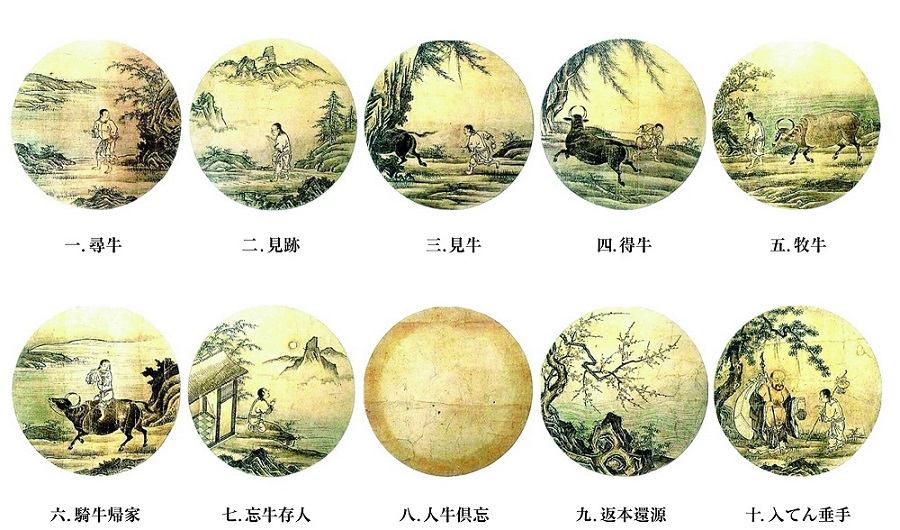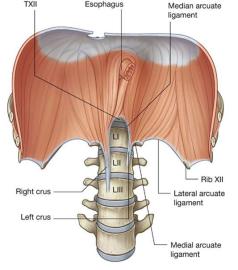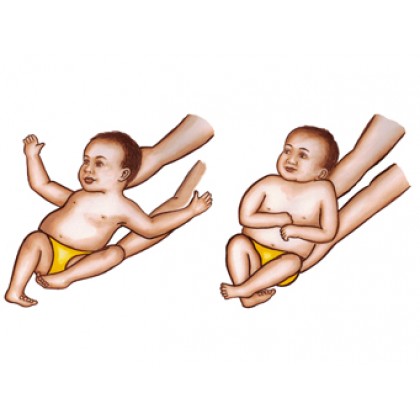The Ten Oxherding Pictures
A Holiday Gift from the Buddhist World to all of us.
The ten Oxherding Pictures from Zen Buddhism represent the stages and path to awakening, integration and enlightenment, with the Ox representing our True Nature and the Oxherder each of us, the embodied being. It is important to note that the stages are not linear but spiralic and multi-dimensional, as we usually can get glimpses of more advanced levels before we have truly completed and integrated the any or all of the previous ones.
Also, we may often be working with several stages at the same time. More subtle awakenings in one level may trigger unconscious and unresolved traumas stored in the earlier levels that then need to be revisited, transformed and integrated. Then, the energy held in trauma is resolved and free to use for deeper growth.
There are many variations on the ten pictures representing the stages, and these are usually accompanied by poetic verses and/or commentary describing the journey. The paintings seen below are traditionally attributed to 天章周文 Tenshō Shūbun (1414-1463), of the Muromachi period in the late fifteenth century and are found at the Shōkokuji temple in Kyoto, Japan.
These stages can be seen as three sets of three transformations, with the final stage standing alone. The first three are the beginners journey, the second three those of the intermediate student, and the final three the most subtle and refined. The tenth transcends all and resolves as the awakened Buddha in the world helping others. Looking more deeply and ironically, we find that ultimately it is the Ox who is training and leading the Oxherder

1: Seeking the Ox
We know something is missing in our lives, but don’t know what it might be, or where to look. Our souls ache, our spirit feels fragile. The spiritual journey begins, but our minds are full of confusion and delusion. Our search is random and we cannot find the Ox anywhere. This is Dante at the beginning of The Divine Comedy.
2: Seeing Tracks of the Ox
Through study and guidance we begin to get glimpses. Maybe we discover yoga or meditation, or find spiritual teachers or writings that inspire us. But although we see the tracks, the Ox is still unseen, unknown. The tracks give us some confidence and we continue seeking, driven by the awakening cosmic impulse to discover/uncover the fullness and truth of our Being. The Ox is calling us.
3: First Glimpsing the Ox
There is the Ox. Wow! So magnificent! How did we ever not see! But the Ox remains elusive, disappearing into the forest. How could that be? Our minds are still confused, our seeking still undisciplined. The Ox teases us. She is everywhere and then nowhere to be found. Our mental habits and beliefs still dominate in spite of the revelation and we struggle to find ground. We are still beginners on the journey.
4: Catching the Ox
We finally catch the ox and grasp the rope to hold her, but she is wild and free, used to cavorting in the fields. We must hold the rope firmly and steadily. The rope of course is our evolving meditation practice and this is where it gets more serious. We are no longer beginners. We are in the realm of un-abiding awakening and must be ‘all in’ with our practice to stabilize the ground. Habits and conditioning have many tentacles extending into the unconscious, so our discipline must become stronger. The Ox keeps us on our toes.
5: Taming the Ox
As our practice becomes stronger, we can hold the rope more loosely as the Ox is relaxing somewhat. It is actually the mind that is relaxing as we begin to realize that the Ox is always steady and it is our minds that are wild and untamed. By relaxing our efforts, our practices can now include resting in the infinite and we become more comfortable in stillness and mystery. Habits still arise as the unconscious has many layers and levels of confusion and trauma, but we recognize the reality that our thoughts arise and fall from the depths of silence and that our delusion is self created.
6: Riding the Ox Back Home
The seeking and struggle come to an end and we can let go of the rope as Ox and herder are one, moving effortlessly together though the world. Buddha Nature is awake and free and we feel spontaneous joy and happiness. The Oxherder plays his flute for the birds and children of the village. This joy and delight can be a surprise as the practice has seemed quite serious at times. Unseen unconscious traumas may still exist so vigilance is still required.
7: Ox Forgotten, Self Alone
The Ox is now gone and the Oxherder sits at home alone. This is ‘Self as ‘I am’ without the need to ‘be something. This is Kaivalya of the Yoga Sutras, Purusha distinct from Prakriti. Up until now, there has remained a subtle sense of duality, of practice and life, of spiritual and not spiritual. This now dissolves. There is no longer ‘something to do’. Everything is meditation and nothing is special. Things are ‘just as they are’.
8: Ox and Self Both Forgotten
Total Emptiness. No concepts, ideas or beliefs, no sense of separateness. Even the “I am” is gone. All gone. Not even the scent of ‘holiness’ or special-ness remains. Gate, Gate, Paragate, Parasamgate.
9: Return to the Source
From the realization of Emptiness emerges the realization that the amazing flow of life always continues on in its own perfection. Seasons come and go. Cherry trees bloom in the spring. Birds sing and the rivers flow. Stars are born and others explode into cosmic dust. Emptiness is Fullness, Fullness is Emptiness. Bodhi svaha!
10: Returning to the Marketplace with Helping Hands
The enlightened being joyfully joins the world to aid all beings on their journey. Freedom, wisdom and compassion are the roots of action. Enlightenment is not passive but celebratory and engaged.
Here are some other perspectives:
From Tricycle Magazine
https://terebess.hu/english/Kuoan1.html
https://terebess.hu/english/oxherd0.html




